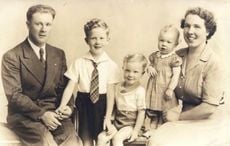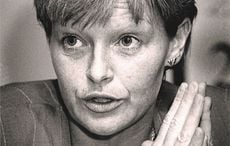| Felix Dolan and his son Brendan |
Amassed on the left-hand side of the church was a phalanx of more than 50 Irish traditional musicians encompassing the pride of New York in a multigenerational show of admiration and respect for one of its most venerated members, Felix Joseph Dolan who passed away on April 9 at the age of 76.
It was just the kind of salute you would expect for one of the most popular Irish musicians to ever come out of New York, and fair play to McManus, whose Fermanagh roots and sensibilities opened up the church to such a musical farewell and tribute.
When Dolan passed away not only were the ranks of the senior citizens playing Irish music diminished in the U.S., but he was one of the more revered Irish Americans in the scene on either side of the Atlantic Ocean.
Raised in the Bronx neighborhood of Highbridge heavily populated by native Irish like his parents Bridget (Castlebar, Co. Mayo) and Felix (Manorhamilton, Co Leitrim), the Dolan household where Felix and his sister Mary were reared was filled with Irish music either from Bridget’s accordion, Irish radio programs or the phonograph.
Felix took up the accordion first in the Bronx and later the instrument for which he was most known for the piano while away at the De La Salle Christian Brothers Formation House in Barrytown, New York. He did so for the most part on his own with minimal instruction from others heavily relying on his own musical instincts as he grew older.
After leaving the Novitiate upstate, Felix linked up with the Bronx All Accordion Band and then older Irish traditional musicians like Paddy Killoran, Paddy O’Brien and Larry Redican at places like the Irish Institute in Manhattan and also Manhattan’s City Center Ballroom with Paddy Noonan and Brendan Ward, where he really honed his piano-playing skills playing during a seven-year stint.
Playing for dancing also won him the heart of Joan Lynch (who he would eventually marry), one of the McNiff dancers for whom he would play along with Redican.
In 1960 he was part of an august group of musicians who represented New York at the Fleadh Cheoil in Boyle, Co. Roscommon which was indicative of the type of company his very stylish piano accompaniment would merit for more than half a century since.
Dolan began a successful career with IBM in 1963 while still playing music that would eventually lead to moving to Golden’s Bridge in upper Westchester County as the family of four children grew (Phelim, Siobhan, Brendan and Deirdre).
There wasn’t as much time for music with the growing family and Dolan retreated somewhat from the scene in New York, but not before he got involved in making one of the most influential records in Irish music history in 1965 when the trio of Andy McGann, Joe Burke and Dolan went into a studio to make 'A Tribute to Michael Coleman' on the Shaskeen label.
| Felix Dolan had another favorite hobby, fishing. |
Dolan’s tasteful playing and chord work went a long way towards erasing the nightmares of “less sympathetic” backers who plagued some of the earlier Irish instrumental recordings, and his reputation as the go-to-guy for piano accompaniment, especially among the older musicians, was being steadily enhanced.
More recording work followed as the Clare accordion player Bobby Gardiner, who was living in Connecticut and would run into Dolan at sessions around New York and the Catskills, asked him to accompany him on his Clare Records label’s 'Traditional Irish Music: Bobby Gardiner Accompanied by Felix Dolan' that came out in 1968.
Later the trio of Burke, McGann and Dolan recorded 'The Funny Reel' on Shanachie Records in 1979 which further solidified his steady and calming influence on the melody playing Irish instrumentalists as well as budding piano accompanists who sought to emulate his style of playing.
An overseas IBM assignment brought the Dolan family to Paris and another hiatus from the music scene from 1981 to 1984. When he returned to the U.S., many musicians young and old were delighted to have him back, and invitations for live concert and recording work flowed as consistently as his piano playing.
The metropolitan New York Irish music scene was growing significantly with the folk music revival well underway with places like the Eagle Tavern and later the Blarney Star having weekly Irish music concerts in the pure drop vein. Many of the artists sought out Dolan, whose stature as a tasteful and complimentary accompanist rivaled that of his height.
In 1986 Felix and his wife Joan, along with the Killeen and Melanophy families, started a monthly ceili dance in Bedford Hills that drew dancers from all over who were more than willing to drive for hours to enjoy the gorgeous music that gave lift to the dancers in both the ceili and set dance vein.
Because it coincided with the set dancing revival well underway here, it became a very important dance series. Dolan anchored on the keyboard and matched that with a great community hall vibe and hospitality.
Dolan also established himself as the premier ceili band keyboard player with a number of ceili bands and ceilithe over the years since Bedford Hills was launched, and in the process became someone who encouraged and educated other musicians through his command of the ceili dance forms and tempos.
More artists wanted Felix for their recordings like John Whelan (From the Heart, 1990), Tom Dougherty (Take the Bull by the Horns, 1992), Seamus Connolly, Martin Mulhaire, Jack Coen with Dolan (Warming Up, 1996), Paddy Reynolds, Charlie Mulvihill (Sweet and Traditional Music of Ireland), Gearoid O’hAllmhurain and Patrick Ourceau (Tracin’, 1999), Catherine McEvoy (Traditional Music in the Sligo Roscommon Style, 1997), Brian Conway (First Through the Gate, 2002), and Catherine and John McEvoy (The Kilmore Fancy, 2004).
In 1994 when the button accordion whiz Joe Derrane made a grand re-entry into the Irish music scene at the Wolf Trap Irish Festival he choose Dolan as his accompanist which led to the Green Linnet recording Give Us Another.
And Dolan’s last CD was a live concert recording made in Chicago, 'A Tribute to Andy McGann,' featuring Brian Conway and Joe Burke, released in 2007.
From the time of the Snug Harbor Irish Arts Center trad festivals in the 1980s in New York, it seems like Dolan’s name would appear on countless festival programs around the country where trad music featured prominently. His reputation for peerless playing and cool-headedness under pressure helped calm many nervous veteran musicians who needed and appreciated his affable guidance.
I am not sure if the serenity and patience associated with his other hobby, fishing, provided some transference that helped quell many a looming disaster on stage with musicians who found it challenging to produce a set list and performance in time for their scheduled stage time.
At Dolan’s Mass, his close musical compatriot Catherine McEvoy, who travelled from Ireland to attend, referred to him as a “legend who will go on and on even though he is no longer with us.”
Her words rang so true, as did the universal description by everyone who attended the wake of Dolan as being the complete gentleman with a smile as broad as his interest in people around him and his family.
As the child of Irish immigrants he would be described as a “narrowback,” the term for Irish Americans whose capacity for hard work might come up short.
But Dolan had broad shoulders and a comforting talent and nature that put him at the top of list of Irish Americans who stood tall in making traditional Irish music and dance as healthy as it is these days.
It is common when a great man like Dolan passes away to say that his like will not be here again, but I would not be in total agreement with that at least not in the musical sense.
Tradition is best served when it is lovingly passed on, and through his son Brendan, with whom he shared both the piano playing expertise and also a love of flute playing, he has ensured that another Irish American will proudly follow in his footsteps.
Dolan left the Irish music scene a much better place, and for that he will never be forgotten.




Comments